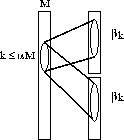In this paper, we are primarily concerned with randomly-wired splitter networks. A randomly-wired splitter network is a splitter network where the up and down edges within each splitter are chosen at random subject to the constraint that each splitter input is incident to d up and d down edges, and each splitter output is incident to 2d incoming edges.
The crucial property that randomly-wired splitter networks are likely
to possess is known as expansion. In particular, an M-input
splitter is said to have ![]() -expansion if every set of
-expansion if every set of ![]() inputs is connected to at least
inputs is connected to at least ![]() up outputs
and
up outputs
and ![]() down outputs, where
down outputs, where ![]() and
and ![]() are
fixed constants. For example, see Figure 4.
are
fixed constants. For example, see Figure 4.
A splitter network is said to have ![]() -expansion
if all of its splitters have
-expansion
if all of its splitters have ![]() -expansion. More simply,
a splitter or a splitter network is said to have expansion if
it has
-expansion. More simply,
a splitter or a splitter network is said to have expansion if
it has ![]() -expansion for some constants
-expansion for some constants ![]() and
and
![]() . A splitter network with expansion is more commonly known
as a multibutterfly [29], and a multibutterfly
with
. A splitter network with expansion is more commonly known
as a multibutterfly [29], and a multibutterfly
with ![]() -expansion and multiplicity d consists of
splitters in which each splitter input is incident to d up and d
down edges and for which any
-expansion and multiplicity d consists of
splitters in which each splitter input is incident to d up and d
down edges and for which any ![]() splitter inputs are
adjacent to
splitter inputs are
adjacent to ![]() splitter outputs.
splitter outputs.
Splitters with expansion are known to exist for any ![]() , and
they can be constructed deterministically in polynomial time
[11, 23, 29], but randomized wirings typically
provide the best possible expansion. In fact, the expansion of a
randomly-wired splitter will be close to d-1 with probability close
to 1, provided that
, and
they can be constructed deterministically in polynomial time
[11, 23, 29], but randomized wirings typically
provide the best possible expansion. In fact, the expansion of a
randomly-wired splitter will be close to d-1 with probability close
to 1, provided that ![]() is a sufficiently small constant. (For
a discussion of the tradeoffs between
is a sufficiently small constant. (For
a discussion of the tradeoffs between ![]() and
and ![]() in
randomly-wired splitters, see [20, 29].)
in
randomly-wired splitters, see [20, 29].)
A multibutterfly with ![]() -expansion is good at routing
because one must block
-expansion is good at routing
because one must block ![]() splitter outputs in order to block
k splitter inputs. In classical networks such as the butterfly, the
reverse is true: it is possible to block 2k inputs by blocking only
k outputs. When this effect is compounded over several levels, the
effect is dramatic. In a butterfly, a single fault can block
splitter outputs in order to block
k splitter inputs. In classical networks such as the butterfly, the
reverse is true: it is possible to block 2k inputs by blocking only
k outputs. When this effect is compounded over several levels, the
effect is dramatic. In a butterfly, a single fault can block ![]() switches l levels back, whereas in a multibutterfly, it takes
switches l levels back, whereas in a multibutterfly, it takes
![]() faults to block a single switch l levels back.
faults to block a single switch l levels back.

Figure 4: An M-input splitter with ![]() -expansion.
-expansion.
In 1989, Upfal showed that any N-input multibutterfly can route any
one-to-one problem in ![]() steps using a simple greedy
algorithm [29], and that, by using pipelining, any N-input
multibutterfly can route
steps using a simple greedy
algorithm [29], and that, by using pipelining, any N-input
multibutterfly can route ![]() one-to-one problems in
one-to-one problems in ![]() steps. Although the proof is complicated and the constants hidden
by the Big Oh notation are large, the result is important because the
only previously known deterministic on-line linear-hardware
steps. Although the proof is complicated and the constants hidden
by the Big Oh notation are large, the result is important because the
only previously known deterministic on-line linear-hardware ![]() -step packet routing algorithm [18] requires the use
of the AKS sorting circuit [1] (which is even more
complicated and has even larger constant factors).
-step packet routing algorithm [18] requires the use
of the AKS sorting circuit [1] (which is even more
complicated and has even larger constant factors).